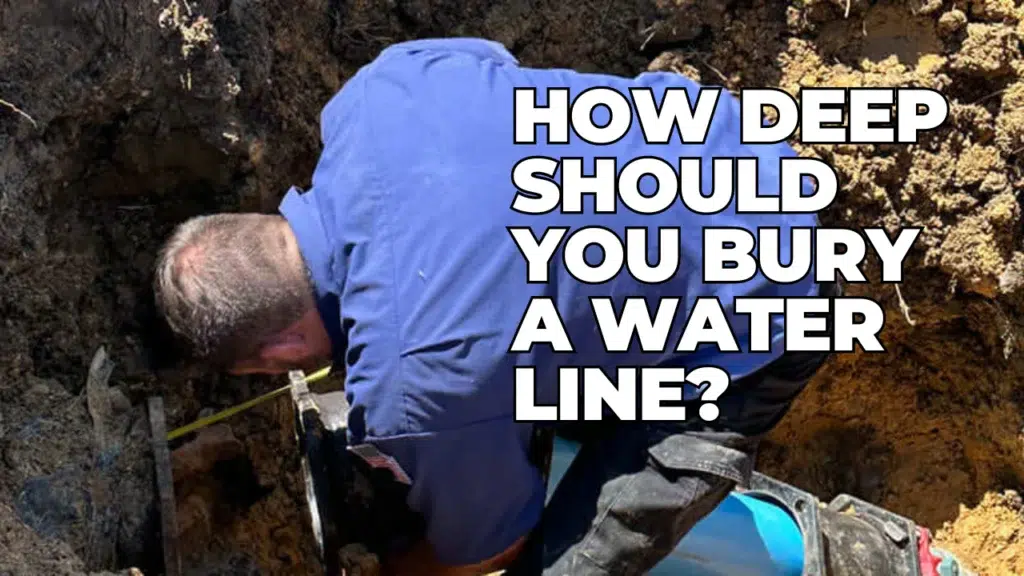How Deep to Bury Water Line
Properly burying water pipes is important to ensure a reliable and long-lasting water supply for your home. If the line is not buried deep enough, it can freeze in the cold, leading to costly repairs and problems.
How Deep Should You Bury a Water Line?

The depth at which a water pipe is installed can greatly affect its functionality, longevity, and resistance to damage, especially from freezing in colder climates.
Below is a detailed guide to help you determine the ideal depth to bury a water pipe.
Understanding the Frost Line Burial Depth
The frost line, also known as the freezing depth, is the depth at which the ground typically freezes during the winter. Burying the water line below this depth is crucial to prevent it from freezing and potentially bursting. The frost line varies depending on your location, from just a few inches in warmer climates to several feet in colder regions.
Warm Climates: In regions with mild winters, such as the southern United States, the frost line may be only 12 to 18 inches deep. In these areas, water lines are typically buried at a minimum depth of 12 to 24 inches.
Cold Climates: In colder areas, such as the northern United States or Canada, the frost line can extend as far as 48 inches or more. Here, water lines must be buried at least 4 feet deep, although local regulations may require even deeper installations.
Local Building Codes and Regulations
Before digging, it is essential to check local building codes or regulations. These codes often specify the minimum depth for water lines to ensure they are protected from environmental factors and potential damage. Your local authority or building department can provide information specific to your area, including any permits required to dig.
Soil Type and Ground Conditions
The type of soil and ground conditions in your area can also influence how deep you should bury your water line. For example, clay soils, which hold water and freeze more easily, may require a deeper installation compared to sandy soils, which drain better and are less likely to freeze.
Clay soil: Prone to holding water and freezing more quickly, requiring deeper burial.
Sandy soil: Drains well and may not require as deep an installation.
Recommended Depths
In Cold Climates: In areas with severe winters, water lines are typically buried at least 12 to 24 inches below the snow line. It may be necessary to bury the hammer deeper.
In Temperate Climates: In areas with mild winters, snow depth is typically between 6 and 12 inches.
Depth for Different Types of Water Lines
The type of water line you are installing can also determine the depth needed:
Main water line – This line needs to be buried deep enough to prevent any damage from freezing and to protect it from accidental digging. Typically, this line is buried at least 36 inches deep.
Lateral lines or irrigation lines – These may not need to be buried as deep as the main water line. Depending on their purpose and local climate, they can be buried anywhere from 12 to 24 inches deep.
Pipe materials
The type of pipe you use also details how you should bury it:
PVC pipe – PVC (polyvinyl chloride) pipe is common for residential plumbing. It is typically not as cold-resistant as other materials and therefore should be buried beneath cold pipes to prevent damage.
PEX pipe – PEX (cross-linked polyethylene) pipe is more flexible and freeze-resistant compared to PVC. When the humidity is cold, some expansion can be tolerated, but it is still best to bury them below frost for added protection.
Copper Pipes – Copper pipes are durable and very resistant to frost damage, but they should be stored below cold pipes to prevent them from freezing.
Additional Considerations
Slope and Grade – Make sure the trench for the water line has an adequate slope to allow for water drainage and prevent water from pooling around the pipe, which can lead to freezing.
Pipe Insulation – In areas where burying the pipe below the frost line is a challenge, consider insulating the water line. This can provide additional protection against freezing.
Safety Precautions
Before you begin digging, it is critical to contact your local utility companies to mark the locations of underground utilities. This will help you avoid damaging gas, electric, or other utility lines during the digging process.
How deep should a water line be to keep it from freezing?

In the United States, the standard depth for water lines is around 36 inches, but the minimum depth depends on local conditions:
Frost Level
The International Plumbing Code (IPC) and the International Residential Code (IRC) state that water lines must be at least 6 inches below the freezing level of the area. The freezing level is the depth at which the ground freezes during the winter and can vary across the country and even within the same area.
For example, if the freezing level is 24 inches below ground level, the water line must be at least 30 inches below ground level. In colder regions where the ground freezes more deeply, it may be necessary to bury water lines up to 48 inches or more below the surface.
Conclusion
Burying a water pipe requires careful consideration of the frost line, local building codes, soil conditions, and the type of water pipe you are installing. By following these guidelines, you can ensure that your water pipe is installed at the proper depth, which will protect it from freezing and damage and ensure a reliable, long-lasting water supply.
Always take the time to research and comply with local regulations, and consult a professional if you have any doubts about the proper installation depth.
Call Now for Drain Cleaning – Home Service | Plumbing Services
Thanks
